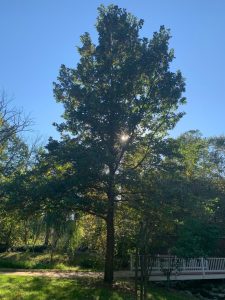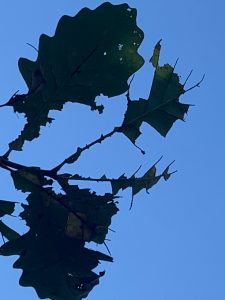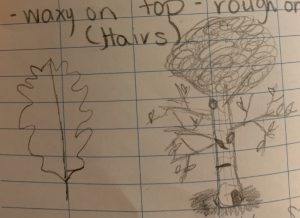
Swamp White Oak tree
For my species summary, I chose to identify a swamp white oak tree scientifically known as Quercus bicolor. This tree is to the 14 feet west of my sit-spot, and I hadn’t noticed this tree until today. I noticed the tree as I was watching a squirrel run through the grass. The reason I picked this tree was because of the leaves, they had an odd shape (the lobes were shaped like they should be prickly, but they weren’t). I can normally identify oak trees, which came as a surprise to me once I discovered that this tree was an oak.

Swamp White Oak leaf

damage the bugs were causing to the leaves.
The weather was rather warm for the fall; 81 degrees Fahrenheit with a slight breeze keeping ir from being too hot. There was not a cloud in the sky this afternoon, showing the beautiful blue sky. After I began to observe the tree, I picked a leaf. The leaf was waxy in the top, and in the underside the hairs made the leaf feel rough. I then noticed that there were very tiny bugs on the underside of the leaf, I did not think anything about this until I did some digging on the tree. Apparently, these leaf gnawing pests are dangerous to the tree. These pests feed on leaves, completely destroying the leaves. When the leave is eaten by the insects, this disrupts photosynthesis, which will weaken growth, this may even cause death to the plant (Snyder, 1992).

drawing on leaf and tree.

Underside of the leaf, If you look closely you will be able to see the tiny insects.
The tree’s leaves were just beginning its transformation into the fall colors before falling. The bark was interesting to me, there were knots in the truck that look like they may have been branches but I am not entirely sure. There were also what looked like lacerations on the truck, but again I was unsure if the bark naturally grew like this.

The knots and lacerations on the bark.
The swamp white oak is a native deciduous tree that is in North America primarily found in Chicago and Illinois. This tree can also be found in the midwestern states from Iowa, southern Wisconsin, Michigan, and Ohio south to northern Kentucky. There are a few isolated populations in Minnesota, New England, Quebec, Ontario, Tennessee, and North Carolina (Snyder, 1992). Swamp white oak trees can grow anywhere from in the middle of a city, near a riverbank, and in drought conditions. This ability is due to its rarity that it can grow in almost any soil type but favors those soils that are heavily compacted (Keeffe, 2019). The leaves of swamp white oak trees range from 10-14 lobes and are about 4.7-7.1 inches long (Snyder, 1992). In optimum conditions, these trees can grow and stand 75ft tall, but on average they grow up to 50ft (Keeffe, 2019). The fruit that is produced from these trees are acorns that are important for wildlife (squirrels, white-tailed deer, beaver, and a variety of birds), the acorns ripen from August through December (Snyder, 1992). Swamp oak trees are sexual that reproduce by seeds and mature in one year.
I first identified my organism by calling my dad and asking him what he thought the tree may be. I then searched from quite some time trying to decide what my tree actually was, which was irritating at times. I looked up “odd looking lobes that aren’t prickly,” and I searched the same things but with trees in front of it. Believe it or not, this is how I actually found what my trees was. Now that I look back, it was fun in a way because it was a challenge to find out what my tree actually was. I finally found the identification of my tree on “fed.us.” This experience was neat, and I will now know what to do/look for during the next species summary that we have.
References Cited
Keeffe, C. (2019, October 21). Urban and Community Trees: Swamp White Oak. Retrieved from https://extension.unh.edu/blog/urban-and-community-trees-swamp-white-oak
Snyder, A. (1992). Index of Species Information. Retrieved from https://www.fs.fed.us/database/feis/plants/tree/quebic/all.html

I really liked how you included information about the pests that are creating damage on the leaves. I also liked the pictures you included so we can see exactly what you are describing. I think it’s really funny what you looked up to eventually identify your organism. I’m glad it worked.
I love that when you looked up the tree type, you used those exact words. Being able to ask your dad about the tree is really cool too, as I’m from a big city and my family doesn’t really know how to identify tree species.
I love your descriptions! One question! Do you know the name of the insects that eat the leaves? Is it one specific insect species or multiple?